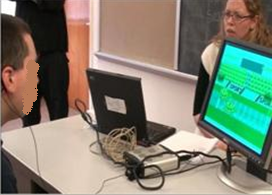Computerized
Interventions to Promote Verbal
Expression in Individuals with
Autism Spectrum Disorder

Approximately one third to one half of individuals on the autism spectrum have significant difficulty using speech and language as an effective means of communication. Their difficulties in speech production and processing can result in interpersonal interactions being overwhelming, confusing, and stressful. Also, these difficulties often get misinterpreted as a general disinterest in social interaction.
The goal of this project is to introduce novel technology that automatically identifies areas of speech production difficulties such as loudness and speech rate, and provides an interactive interface for individuals to make an attempt to rectify it. This study is motivated by our hypothesis that real time visualizations of speech properties, which often act as social mirrors, can influence social communication. Our objective is not to replace the traditional speech therapist with this tool. Instead, we propose this tool being an easily customizable and freely available supplementary therapy to help individuals with speech difficulties.
Publications:
1. M. E. Hoque, J. K. Lane, R. elKaliouby, M. Goodwin, R. W. Picard, Exploring Speech Therapy Games with Children on the Autism Spectrum, In Proceedings of InterSpeech, Brighton, UK, September, 2009.
2. M. E. Hoque, Analysis of Speech Properties of Neurotypicals and Individuals Diagnosed with Autism and Down Syndrome, 10th ACM conference on Computers and Accessibility (ASSETS), Halifax, Nova Scotia, October, 2008.